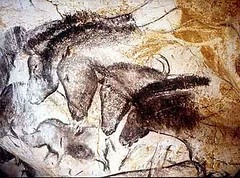The Pleistocene is the epoch from 2.588 million to 12,000 years BP (before the present) covering the world's recent period of repeated glaciations.
The name pleistocene is derived from the Greek πλεῖστος (pleistos "most") and καινός (kainos "new").
Pleistocene climate was marked by repeated glacial cycles where continental glaciers pushed to the 40th parallel (Shreveport is at the 32nd parallel) in some places. It is estimated that, at maximum glacial extent, 30% of the Earth's surface was covered by ice.
The sum of transient factors acting at the Earth's surface is cyclical: climate, ocean currents and other movements, wind currents, temperature, etc. The waveform response comes from the underlying cyclical motions of the planet, which eventually drag all the transients into harmony with them. The repeated glaciations of the Pleistocene were caused by the same factors.
The similarity of our present interglacial interval (known as the Holocene, Postglacial, or the Present Interglacial) to that of an earlier one about 400,000 years ago suggests that the next glacial will begin in about 20,000 years.
A major extinction event of large mammals (megafauna), which included mammoths, mastodons, saber-toothed cats, glyptodons, ground sloths, Irish elk and cave bears began late in the Pleistocene and continued into the Holocene.
Neanderthals also became extinct during this period.
At the end of the last ice age, cold-blooded animals, smaller mammals like wood mice, migratory birds, and swifter animals like whitetail deer had replaced the megafauna and migrated north.
Scientific evidence[11] indicates that humans evolved into their present form during the Pleistocene.[12]
skip to main |
skip to sidebar
For students and parents who love education and exploration of the social sciences . . .
Search This Blog
Followers
Blog Archive
-
▼
2010
(346)
-
▼
May
(40)
- Apple Passes Microsoft as No. 1 in Tech, reports N...
- Semester exam: 100 multiple choice questions
- Constructed response on the semester exams
- Continent of Africa, continent of Africa quiz and ...
- Demographics and topical issues quizzes
- Caribbean islands quiz, Brazil quiz
- Climate change quiz, Wolfgang Amadeus Mozart quiz,...
- Aussie history: the novel and movie "Rabbit-proof ...
- Exam review: some 70 questions for your study
- Thurs quiz: demonstrate knowledge of Australia via...
- Cro Magnons and the spread of homo sapiens
- What happened during the long period of glaciation...
- Magnet geography: Australia graphics
- Aboriginal Australian figure from Dreamtime
- Rock art motifs from Kakadu National Park, east of...
- James Woods @ Magnet Shreveport: Aborigine culture
- Billabong and Outback: Australian terms used by su...
- Australia map quiz Thurs: Uluru, etc
- Notes on Oz, aka Terra Australis
- Chemicals and cancer: panel cautions Americans on ...
- Basic Japanese language phrases from Dailymotion.c...
- A Japanese Haiku: simplicity, profundity
- Hayao Miyazaki's animated movie, Spirited Away: th...
- Kelsey Phillip Payne @ Magnet Shreveport geography
- Japanese drink Oronamin C: William Wilcox, Larsson...
- Bento, the colorful, elegant boxed lunch of the Ja...
- The anime eye, or manga eye, was created by Japane...
- Fugu Restaurant: Shibuya
- Shinkansen, known as a Bullet Train, zooming throu...
- Costumed girls hanging in the Harajuku area of Tokyo
- Geography @ Magnet: the Tibetan Buddhist Prayer Fl...
- The Gulf of Mexico and its fish: Capt Markham Dickson
- Japanese folk rock: the Yoshida Brothers
- Tibetan Buddhists also use the sand mandala as a s...
- Japanese Stone Lantern typically found in gardens ...
- Buddhism: the eight-spoked wheel is a symbol of th...
- British Petroleum Deepwater Horizon oil spill loca...
- Would you like to construct a Japanese mini dry la...
- Japanese mini dry landscape garden
- Indie work: seeing parallells in the histories of ...
-
▼
May
(40)

